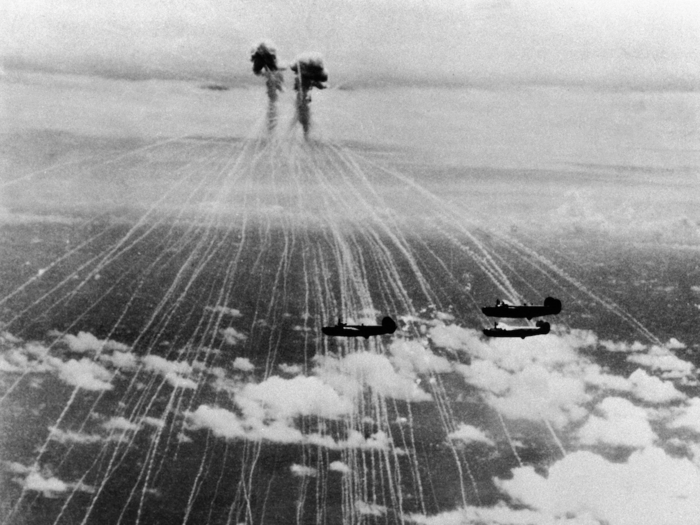
Iwo Jima's location provided Japanese fighters with a base to intercept US aircraft on their way to attack the Japanese mainland, and it was an important station for its Navy. The US decided it had to be taken, and the first operations against Iwo Jima started as early June of 1944.
But the island had been turned into a fortress by Lieutenant General Tadamichi Kuribayashi. By the time the Americans invaded, Japanese soldiers had dug 11 miles of bunkers and tunnels all around the island.
Because they were so deep, the Japanese could wait out any bombardments. One bunker was up to 90 feet deep.

The commander of the Marine landing force had originally requested 10 days of shelling the island, but the Navy cut it down to three.
Bad weather, combined with the Japanese tunnel and bunker networks limited the damage that the barrages could do. Some American ships were even hit by returning fire from the Japanese.



American high command knew their task would not be easy. Lt Gen Holland M. Smith, the commander of the Fleet Marine Force Pacific, reportedly said "this is going to be a rough one, we could suffer as many as fifteen thousand casualties here."
"It was an operation of one phase and one tactic . . . until the mission was completed it was a matter of frontal assault maintained with relentless pressure," he said.




The Japanese had mortar and artillery positions all over the island. Mount Suribachi's high ground was a perfect area for spotters to give coordinated and call in artillery strikes on the Marines.
Additionally, since the Japanese had burned all the vegetation — and because it was extremely difficult to dig foxholes in the ash — the Marines could not hide and were completely exposed.
They were essentially sitting ducks for artillery and the Japanese soldiers who were shooting at them from bunkers and trenches. Time-Life correspondent Robert Sherrod reported that "Iwo Jima can only be described as a nightmare in hell."


Navy Seabees, known officially as Naval Construction Battalions, are combat engineers. At Iwo Jima, they were tasked with building forward command posts, artillery positions, and field hospitals.
At the same time, they were expected to fight. The Navy had previously used civilian contractors for these jobs, but according to international law, civillian personnel who fight in wars are labeled as guerrillas, which means they can be executed, a loophole the Japanese used after they invaded Wake Island in 1941.


While tactically significant, the main Japanese defense was not at Mount Suribachi. Instead, they were focused on defending the northeastern parts of the island, where the airfields were located.
Joe Rosenthal's famous photo was actually the second raising of a flag over Mount Suribachi. The first flag was smaller and was replaced by the larger one that is in the photo after then-Secretary of the Navy James Forrestal decided he wanted the original flag as a souvenir.
The photo became an important symbol in the United States. The government used it on stamps, posters, and promotional images promoting war bonds. Of the six Marines in the photo, only three survived the battle.

Unlike past battles, the Japanese troops on the island rarely conducted banzai attacks. Kuribayashi had forbidden them, realizing that they were futile.
As a result, the Japanese were purely on the defensive, and they took their toll on the Americans. Lt Gen Holland was impressed by the Japanese resistance. "I don't know who he is, but the Japanese General running this show is one smart bastard," he said.
Captain Dave Severence described the toll on his unit; "easy Company started with 310 men. We suffered 75% casualties. Only 50 men boarded the ship after the battle. Seven officers went into battle with me. Only one — me — walked off Iwo."







By mid-March, the Japanese soldiers were malnourished and holed up in horrible living conditions in bunkers and caves. The air and naval bombardments took their toll on the Japanese.
"I am not afraid of the fighting powers of only three American Marine Divisions if there are no bombardments from aircraft and warship. This is the only reason we have to see such miserable conditions," Kuribayashi reported.

Though his body was never identified, Kuribayashi likely died in a mass attack on American camps on the morning of March 26 that was so intense, it resorted to hand-to-hand combat.
The island was declared secure later that day, though the following three months saw mopping up operations against Japanese holdouts.
According to the AP, this photograph shows a Japanese soldier who was was buried for one and a half days in this shell hole playing dead. After a live grenade inches away from his hand was knocked away he surrendered.
He was then given a cigarette and eventually dragged free from the hole. Many Japanese soldiers who were captured were knocked out or otherwise incapacitated, few surrendered.


 A teenager accidentally hits the accelerator pedal, and a five-year-old boy loses his life in a tragic incident in Bengaluru
A teenager accidentally hits the accelerator pedal, and a five-year-old boy loses his life in a tragic incident in Bengaluru
 Amid growing political uncertainty in Pakistan, IMF expresses concern over its financial stability
Amid growing political uncertainty in Pakistan, IMF expresses concern over its financial stability
 OPINION: Balancing act or pure jugglery — navigating professional challenges as a working mother
OPINION: Balancing act or pure jugglery — navigating professional challenges as a working mother

Copyright © 2024. Times Internet Limited. All rights reserved.For reprint rights. Times Syndication Service.